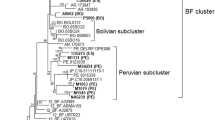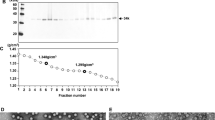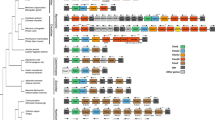Abstract
SIMIAN immunodeficiency viruses have been isolated from four species of monkey, the 'captive' macaque1 and mangabey2–4 and the 'feral' African green monkey5 and mandrill6. While none of these viruses is a replica of HIV-1, the macaque7 and mangabey8 viruses represent correct genetic models for HIV-2, possessing exactly the same complement of genes. Recently a lentivirus has been identified in two wild chimpanzees (Pan troglodytes troglodytes) in Gabon, west equatorial Africa, and isolated from one of them9. This virus is referred to as SIVCPZ. Sera from these animals cross reacted with all the HIV-1 proteins including the envelope glycoproteins. Here, we describe the molecular cloning and sequencing of an infectious proviral clone of SIVCPZ. The overall genetic organization was the same as that of HIV-1, but phylogenetic analysis revealed that the sequence was more divergent than any HIV-1 sequence reported so far. The vpu gene product, found only in the type 1 viruses, was particularly different (64% divergent to HIV-1BRU) suggesting that the SIVCPZ represents a distinct subtype. These findings indicate that there is a larger pool of simian lentiviruses than previously suspected and revives debate as to the origins of HIV-1.
This is a preview of subscription content, access via your institution
Access options
Subscribe to this journal
Receive 51 print issues and online access
$199.00 per year
only $3.90 per issue
Buy this article
- Purchase on Springer Link
- Instant access to full article PDF
Prices may be subject to local taxes which are calculated during checkout
Similar content being viewed by others
References
Daniel, M. D. et al. Science 228, 1201–1204 (1985).
Lowenstine, L. J. et al. Int. J. Cancer 38, 563–574 (1986).
Murphey-Corb, M. et al. Nature 321, 435–437 (1986).
Fultz, P. N. et al. Proc. natn. Acad. Sci. U.S.A. 83, 5286–5290 (1986).
Ohta, Y. et al. Int. J. Cancer 41, 115–122 (1988).
Tsujimoto, H. et al. J. Virol. 62, 4044–4050 (1989).
Chakrabarti, L. et al. Nature 328, 543–547 (1987).
Hirsch, V. M., Olmsted, R. A., Murphey-Corb, M., Purcell, R. H. & Johnson, P. R. Nature 339, 389–392 (1989).
Peeters, M. et al. AIDS 3, 625–630 (1989).
Cornell, C. et al. Bio Techniques 5, 342–348 (1987).
Wain-Hobson, S., Sonigo, P., Danos, O., Cole, S. & Mizon, M. Cell 40, 9–17 (1985).
Alizon, M., Wain-Hobson, S., Montagnier, L. & Sonigo, P. Cell 46, 63–74 (1986).
Guyader, M. et al. Nature 326, 662–669 (1987).
Emerman, M., Guyader, M., Montagnier, L., Baltimore, D. & Muesing, M. EMBO J. 6, 3755–3760 (1987).
Malim, M. H. et al. Proc. natn. Acad. Sci. U.S.A. 86, 8222–8226 (1989).
Klimkait, T., Strebel, K., Hoggan, M. D., Martin, M. A. & Orenstein, J. M. J. Virol. 64, 621–629 (1990).
Hammerschmidt, W., Sugden, B. & Baichwal, V. R. J. Virol. 63, 2469–2475 (1989).
Gurgo, C. et al. Virology 164, 531–536 (1988).
Smith, R. F. & Smith, T. F. Proc. natn. Acad. Sci. U.S.A. 87, 118–122 (1990).
Smith, T. F., Srinivasan, A., Schochetman, G., Marcus, M. & Myers, G. Nature 333, 573–575 (1988).
Wilbur, W. J. & Lipman, D. J. Proc. natn. Acad. Sci. U.S.A. 80, 726–730 (1983).
Huet, T., Dazza, M. C., Brun-Vézinet, F., Roelants, G. E. & Wain-Hobson, S. AIDS 3, 707–715 (1989).
Fukasawa, M. et al. Nature 333, 457–461 (1988).
Tsujimoto, H. et al. Nature 341, 539–541 (1989).
Chen, C. & Okayama, H. Molec. cell. Biol. 7, 2745–2752 (1987).
Staden, R. Nucleic Acids Res. 10, 4731–4751 (1982).
Saiki, R. K. et al. Science 239, 487–491 (1988).
Kyte, J. & Doolittle, R. J. molec. Biol. 157, 105–132 (1982).
Myers, G. et al. Human Retroviruses and AIDS (Los Alamos National Laboratory, New Mexico, 1989).
Felsenstein, J. A. Rev. Genet. 22, 521–565 (1988).
Author information
Authors and Affiliations
Rights and permissions
About this article
Cite this article
Huet, T., Cheynier, R., Meyerhans, A. et al. Genetic organization of a chimpanzee lentivirus related to HIV-1. Nature 345, 356–359 (1990). https://doi.org/10.1038/345356a0
Received:
Accepted:
Issue Date:
DOI: https://doi.org/10.1038/345356a0
This article is cited by
-
Opioid abuse and SIV infection in non-human primates
Journal of NeuroVirology (2023)
-
A great-ape view of the gut microbiome
Nature Reviews Genetics (2019)
-
Circulation of multiple subtypes (A, G and CRFs 02_AG) of human immunodeficiency virus type 1 (HIV-1) in selected districts of Punjab province, Pakistan
Archives of Virology (2019)
-
Isolation of a simian immunodeficiency virus from a malbrouck (Chlorocebus cynosuros)
Archives of Virology (2017)
-
Current views on HIV-1 latency, persistence, and cure
Folia Microbiologica (2017)
Comments
By submitting a comment you agree to abide by our Terms and Community Guidelines. If you find something abusive or that does not comply with our terms or guidelines please flag it as inappropriate.



